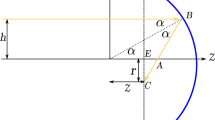Abstract
The Monte Carlo ray-tracing method is applied and coupled with optical properties to predict the radiation performance of solar concentrator/cavity receiver systems. Several different cavity geometries are compared on the radiation performance. A flux density distribution measurement system for dish parabolic concentrators is developed. The contours of the flux distribution for target placements at different distances from the dish vertex of a solar concentrator are taken by using an indirect method with a Lambert and a charge coupled device (CCD) camera. Further, the measured flux distributions are compared with a Monte Carlo-predicted distribution. The results can be a valuable reference for the design and assemblage of the solar collector system.
Similar content being viewed by others
References
Johnston G. Focal region measurements of the 20 m2 tiled dish at the Australian National University. Solar Energy, 1998, 63(2): 117–124
Vittitoe C N, Biggs F. The HELIOS model for the optical behavior of reflecting solar concentrators. Sandia National Laboratories Report No. SAND76-0347, 1976
Ratzel A C, Boughton B D, Mancini T R. CIRCE (Convolution of Incident Radiation with Concentrator Errors): A computer code for the analysis of point-focus solar concentrators. Sandia National Laboratories Report No. SAND-86-1172C. 1986
Leary P L, Hankins J D. A user’s guide for MIRVAL. Sandia National Laboratories Report No. SAND77-8280. 1979
Daly J C. Solar concentrator flux distributions using backward ray tracing. Applied Optics, 1979, 18(15): 2696–2699
Jeter S M. The distribution of concentrated solar radiation in paraboloidal collectors. Journal of Solar Energy Engineering, 1986, 108: 219–225
Jones P D, Wang L L. Concentration distributions in cylindrical receiver/paraboloidal dish concentrator systems. Solar Energy, 1995, 54(2): 115–123
Johnston G. Flux mapping the 400 m2 “Big Dish” at the Australian National University. Journal of Solar Energy Engineering, 1995, 117(4): 290–293
Johnston G, Lovegrove K, Luzzi A. Optical performance of spherical reflecting elements for use with paraboloidal dish concentrators. Solar Energy, 2003, 74(2): 133–140
Imenes A G, Buie D, Mills D R, Schramek P, Bosi S G. A new strategy for improved spectral performance in solar power plants. Solar Energy, 2006, 80(10): 1263–1269
Jaramillo O A, Perez-Rabago C A, Arancibia-Bulnes C A, Estrada C A. A flat-plate calorimeter for concentrated solar flux evaluation. Renewable Energy, 2008, 33(10): 2322–2328
Doron P, Kribus A. The effect of irradiation directional distribution on absorption in volumetric solar receiver. Journal of Solar Energy Engineering, 1997, 119(1): 68–73
Modest M F. Radiative Heat Transfer. 2nd ed. New York: Academic Press, 2003
Siegel R, Howell J R. Thermal Radiation Heat Transfer. 4th ed., New York/London: Taylor & Francis, 2002
Shuai Y, Xia X L, Tan H P. Radiation performance of dish solar concentrator/cavity receiver systems. Solar Energy, 2008, 82(1): 13–21
Liu Y. Theoretical and experimental study on focal flux of solar concentrator. Dissertation for the Doctoral Degree. Harbin: Harbin Institute of Technology, 2008
Author information
Authors and Affiliations
Corresponding authors
Rights and permissions
About this article
Cite this article
Shuai, Y., Xia, X. & Tan, H. Numerical simulation and experiment research of radiation performance in a dish solar collector system. Front. Energy Power Eng. China 4, 488–495 (2010). https://doi.org/10.1007/s11708-010-0007-z
Received:
Accepted:
Published:
Issue Date:
DOI: https://doi.org/10.1007/s11708-010-0007-z




